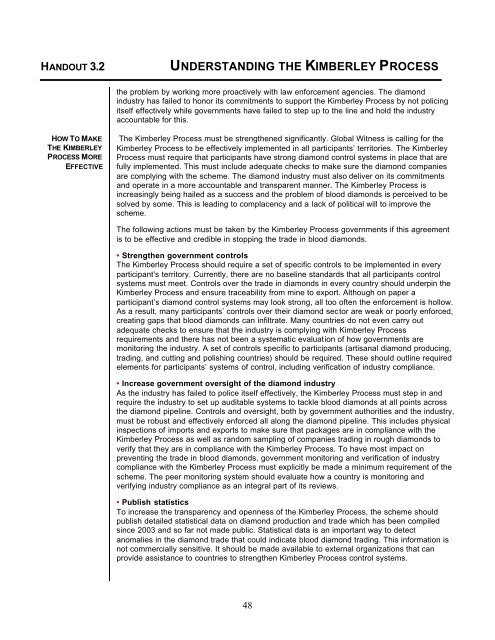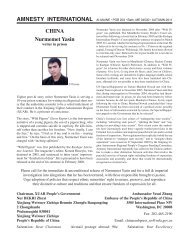Blood Diamond Curriculum Guide (PDF) - Amnesty International USA
Blood Diamond Curriculum Guide (PDF) - Amnesty International USA
Blood Diamond Curriculum Guide (PDF) - Amnesty International USA
You also want an ePaper? Increase the reach of your titles
YUMPU automatically turns print PDFs into web optimized ePapers that Google loves.
HANDOUT 3.2 UNDERSTANDING THE KIMBERLEY PROCESS<br />
HOW TO MAKE<br />
THE KIMBERLEY<br />
PROCESS MORE<br />
EFFECTIVE<br />
the problem by working more proactively with law enforcement agencies. The diamond<br />
industry has failed to honor its commitments to support the Kimberley Process by not policing<br />
itself effectively while governments have failed to step up to the line and hold the industry<br />
accountable for this.<br />
The Kimberley Process must be strengthened significantly. Global Witness is calling for the<br />
Kimberley Process to be effectively implemented in all participants’ territories. The Kimberley<br />
Process must require that participants have strong diamond control systems in place that are<br />
fully implemented. This must include adequate checks to make sure the diamond companies<br />
are complying with the scheme. The diamond industry must also deliver on its commitments<br />
and operate in a more accountable and transparent manner. The Kimberley Process is<br />
increasingly being hailed as a success and the problem of blood diamonds is perceived to be<br />
solved by some. This is leading to complacency and a lack of political will to improve the<br />
scheme.<br />
The following actions must be taken by the Kimberley Process governments if this agreement<br />
is to be effective and credible in stopping the trade in blood diamonds.<br />
• Strengthen government controls<br />
The Kimberley Process should require a set of specific controls to be implemented in every<br />
participant’s territory. Currently, there are no baseline standards that all participants control<br />
systems must meet. Controls over the trade in diamonds in every country should underpin the<br />
Kimberley Process and ensure traceability from mine to export. Although on paper a<br />
participant’s diamond control systems may look strong, all too often the enforcement is hollow.<br />
As a result, many participants’ controls over their diamond sector are weak or poorly enforced,<br />
creating gaps that blood diamonds can infiltrate. Many countries do not even carry out<br />
adequate checks to ensure that the industry is complying with Kimberley Process<br />
requirements and there has not been a systematic evaluation of how governments are<br />
monitoring the industry. A set of controls specific to participants (artisanal diamond producing,<br />
trading, and cutting and polishing countries) should be required. These should outline required<br />
elements for participants’ systems of control, including verification of industry compliance.<br />
• Increase government oversight of the diamond industry<br />
As the industry has failed to police itself effectively, the Kimberley Process must step in and<br />
require the industry to set up auditable systems to tackle blood diamonds at all points across<br />
the diamond pipeline. Controls and oversight, both by government authorities and the industry,<br />
must be robust and effectively enforced all along the diamond pipeline. This includes physical<br />
inspections of imports and exports to make sure that packages are in compliance with the<br />
Kimberley Process as well as random sampling of companies trading in rough diamonds to<br />
verify that they are in compliance with the Kimberley Process. To have most impact on<br />
preventing the trade in blood diamonds, government monitoring and verification of industry<br />
compliance with the Kimberley Process must explicitly be made a minimum requirement of the<br />
scheme. The peer monitoring system should evaluate how a country is monitoring and<br />
verifying industry compliance as an integral part of its reviews.<br />
• Publish statistics<br />
To increase the transparency and openness of the Kimberley Process, the scheme should<br />
publish detailed statistical data on diamond production and trade which has been compiled<br />
since 2003 and so far not made public. Statistical data is an important way to detect<br />
anomalies in the diamond trade that could indicate blood diamond trading. This information is<br />
not commercially sensitive. It should be made available to external organizations that can<br />
provide assistance to countries to strengthen Kimberley Process control systems.<br />
48






